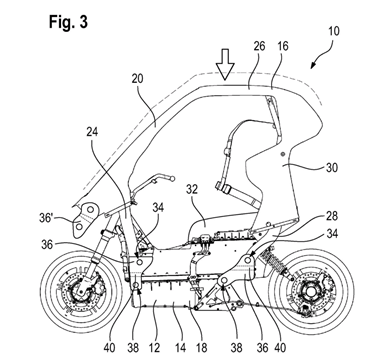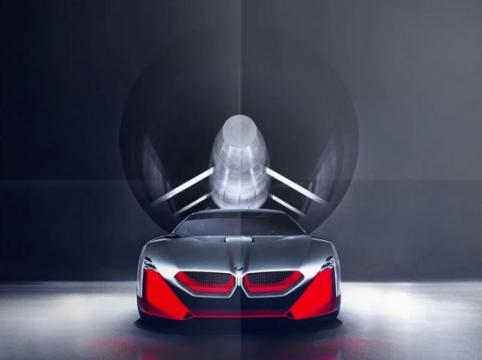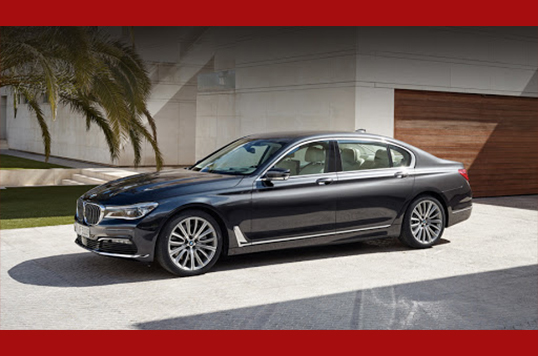
BMW Patents Radical C Evolution New Electric Motorcycle
"When you want a purer riding experience, without all the car-style safety systems, you can simply leave them at home."
BMW has been down the road of roofed bikes before. The C1 scooter, made for just two years between 2000 and 2002, proved a sales flop despite its claim of offering car-style safety. But 20 years on, the firm is getting ready to dive back into the same arena with a completely rethought version of the “enclosed” concept that—most importantly—can be converted back into a “normal” bike by undoing just a few bolts.
“Normal” is relative, of course. The BMW idea—which has been the basis of an astounding 15 patent applications in the last month alone—is an electric machine that appears to be based on the chassis, batteries, and transmission of the C Evolution scooter. Like the C1, the C Evolution is expensive and slow-selling, but unlike its predecessor it represents a form BMW remains committed to, staking its claim as a serious player in the electric bike field.
It includes features like:
Carbon Safety Cell
Weight is every bike’s enemy, and BMW’s solution for the new design is to use carbon fiber. The roof is made of it, while the chassis is an aluminium platform built around the battery packs. Carbon provides immense strength with a minimal weight.
Crumple Zones
The crumple zones are simply bolted to the bottoms of the roof’s pillars, it should be relatively easy to replace them, and so a crash won’t necessarily mean the bike is instantly written off just because a zone has been destroyed.
Seat Belts
Race-style four-point harnesses hold the rider in position during an accident, but the shoulder straps have road-car-style inertia reels to allow them to move until they’re jolted by an impact. At that stage, pre-tensioners tighten the belts to pull the rider back into the seat.
Side Airbags
Airbags set into the side panels expand during an accident, creating a padded section on each side of the rider running from his hips all the way to his shoulders and extending forward as far as his elbows, again keeping his arms inside the safety cell during a crash.
Rear Impact Protection
BMW hasn’t forgotten about rear impacts either. The upright section of the rider’s seat—which is attached to the removable roof rather than the seat base—has a strong cage inside to protect your spine.
Active Aerodynamics
BMW’s solution to that problem is to use active aerodynamics, with four movable winglets to compensate. Connected to a computer-operated stability system, the winglets—two at the front, two at the back—create downforce but also act like an aeroplane’s ailerons.
Removable Roof
All this stuff is impressive technology, but perhaps the cleverest element of all is the fact that BMW has designed it all to be easily removed by undoing just a few bolts.
BMW’s idea appears to be that you can use the protection when you’re commuting, or struggling with bad weather or inattentive drivers and all the other daily trials that motorcyclists face. But when you want a purer riding experience, without all the car-style safety systems, you can simply leave them at home.
It first mooted it with a patent for a removable roof for the C Evolution, filed last year, but the 15 new patent documents show that the concept has evolved significantly since then. Given that BMW already sells electric cars with carbon fiber bodies and chassis, like the i3, it’s conceivable the firm will actually put this into production to further explore the use of the material and electric tech as well as to probe the potential crossover markets between car drivers and motorcyclists.
Source: CycleWorld
Also Read:
BMW 530I SPORT LAUNCHED IN INDIA - PRICE, SPECS | REVIEWS NEPAL
ELECTRIC CAR SALES JUMPED BY 57 PERCENT Q1 2020 IN EUROPE
NEW UPCOMING ELECTRIC CARS IN NEPAL 2020 | PRICE, SPECS
BYD AND TOYOTA'S JOINT VENTURE TO MAKE BATTERY ELECTRIC VEHICLE
AMPERE ELECTRIC OPENS DEALERSHIP IN NEPAL
2020-21 BUDGET IMPACT: ELECTRIC VEHICLES TO BE MORE COSTLY IN NEPAL






